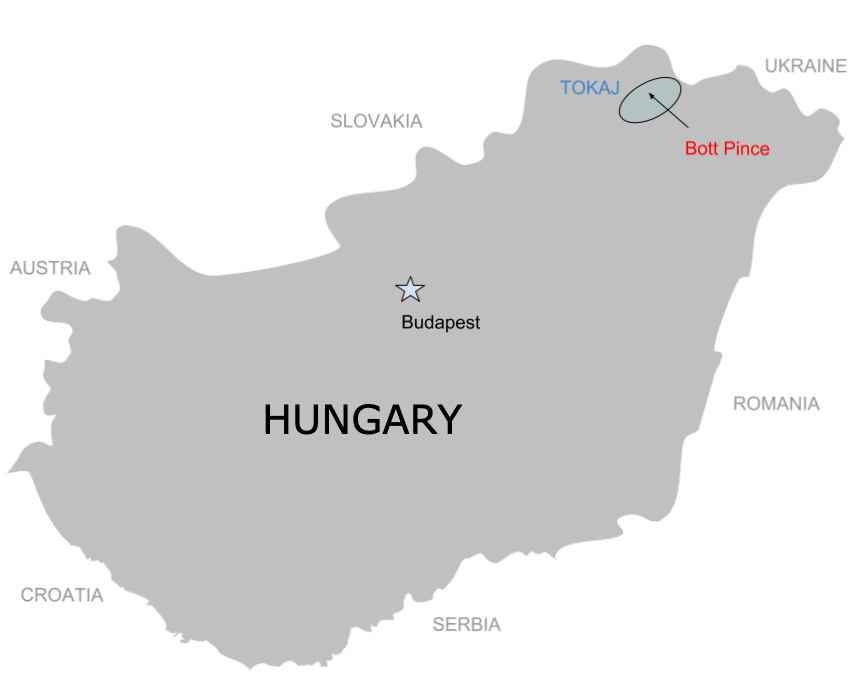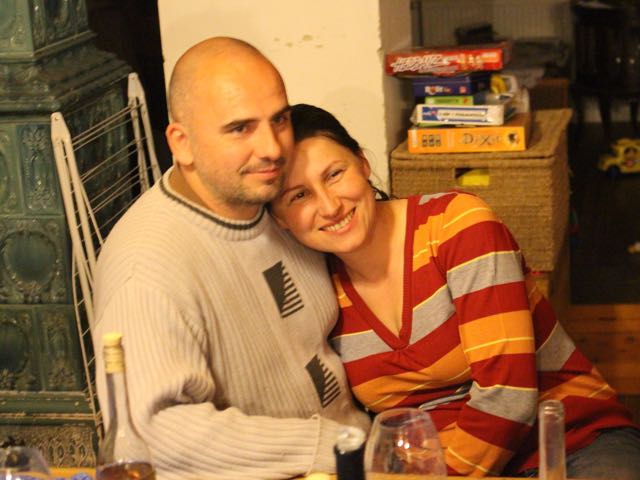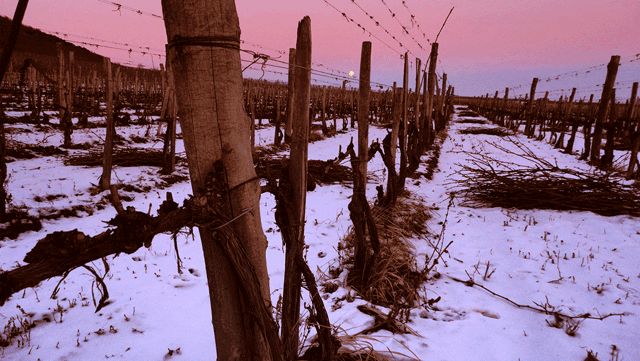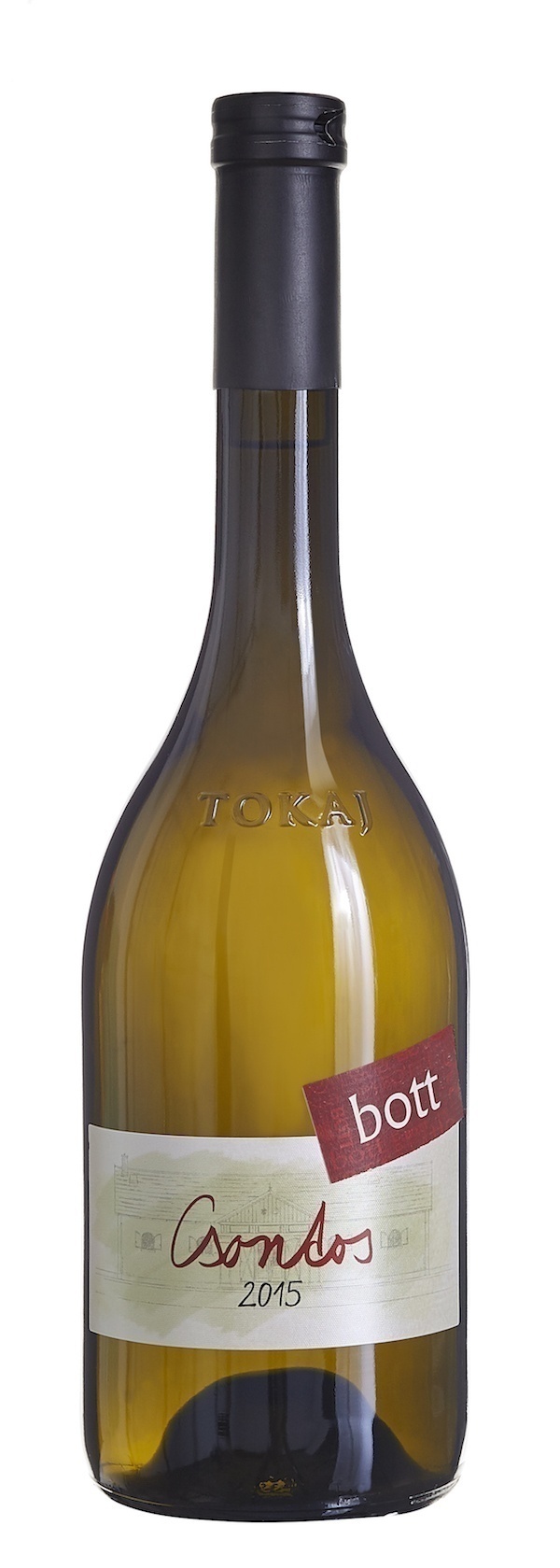

Bott, Tokaj, Hungary
“When we succeed, it brings joy to others that is generously given back to us. Since wine forms the quality of our lives, we like living this way.” — Judit Bodó

At a Glance
2006
http://www.bottpince.hu/
Tokaj
Cool Continental
Clay, limestone and obsidian
170-200m
Low hills and landscapes of vines and forests
Furmint, Hárslevelű
9 hectares
Sustainable
http://www.bottpince.hu/
Tokaj
Cool Continental
Clay, limestone and obsidian
170-200m
Low hills and landscapes of vines and forests
Furmint, Hárslevelű
9 hectares
Sustainable

Judit and József Bodó
The People
The wines of Tokaj are the product of over 1200 years of melting together different cultures, religions, and ethnicities over a truly unique combination of geology and climate. In a way, József and Judit Bodó, both originally from Csallóköz, an ethnic Hungarian region in Slovakia are perpetuating this tradition of cultural exchange.
Following her love for wine Judit went to work for a producer in South Tirol who later hired her onto a project in Tokaj managing the affairs of a small artisan winery: Füleky. Heeding the dream of his wife to have their own winery in Tokaj, József took on the labor of actually looking for vineyards. Upon discovering Csontos, Judit said, “he could not sleep at night.” After the birth of their son, they focused solely on their own family winery with József in the vineyards and Judit in the cellar. In 2005 they bottled wine from just 1 ha, the first vintage of “Bott,” an homage to Judit’s maiden name.
Today the couple tends about 5 ha spread among various sites mostly near the village of Erdőbénye. Wines are made exclusively from indigenous varieties. According to Judit, “When we succeed it brings joy to others that is generously given back to us. Since wine forms the quality of our lives, we like living this way.” There is a maternal touch to the wines she makes, to compare them to children, they are as disciplined as they are loved. Despite making very little wine, Judit and József have made Bott one of Tokaj’s most respected new producers, not just in Tokaj, but all of Hungary.
Following her love for wine Judit went to work for a producer in South Tirol who later hired her onto a project in Tokaj managing the affairs of a small artisan winery: Füleky. Heeding the dream of his wife to have their own winery in Tokaj, József took on the labor of actually looking for vineyards. Upon discovering Csontos, Judit said, “he could not sleep at night.” After the birth of their son, they focused solely on their own family winery with József in the vineyards and Judit in the cellar. In 2005 they bottled wine from just 1 ha, the first vintage of “Bott,” an homage to Judit’s maiden name.
Today the couple tends about 5 ha spread among various sites mostly near the village of Erdőbénye. Wines are made exclusively from indigenous varieties. According to Judit, “When we succeed it brings joy to others that is generously given back to us. Since wine forms the quality of our lives, we like living this way.” There is a maternal touch to the wines she makes, to compare them to children, they are as disciplined as they are loved. Despite making very little wine, Judit and József have made Bott one of Tokaj’s most respected new producers, not just in Tokaj, but all of Hungary.

Driving towards the Hatari vineyard
Vineyards
Closer to Erdőbénye, the Határi vineyard is along the same slopes bordering the Zemplèn forest as the Csontos vineyards, but are instead more western than southern facing. With only 1.5 hectare currently cultivated, the soil is clayey and chock-full of broken up limestone, rhyolite-tufa, and obsidian. Tending to the 35 years-old vines by hand, the Furmint produces wonderfully full-bodied dry wines while the Hárslevelű takes on a special sweetness while remaining particularly mineral which makes it ideal as the base for their Aszú and late harvest wines.

The Csontos Vineyard at night
Winemaking
As is common among some of the best vignerons in Tokaj, Judit and her family personally harvest the fruit ensuring the strictest of sorting. The newly built winery is still small and the equipment consists of relics like an antique wooden press and a medieval looking bladder press from the 60’s. Despite looking less than ideal Judit contends that this equipment forces her to be especially attentive, which ultimately benefits her wines. Wines are fermented slowly in mostly used 220 liter oak barrels with native yeast over a period of 6-8 weeks. This protracted fermentation enhances the elegance and texture of Bott wines. Wines remain in barrel between 7-10 months depending on the vineyard and vintage and are topped regularly. Depending on the vintage and character of a particular vineyard, wines may have residual sugar as Judit lets every barrel finish fermentation without intervention.
The substantial acclaim the Bott wines have received both locally and internationally is remarkable. Judit Bott was featured in a New York Times article on Tokaj Hidden in Hungary,Treasures on the Vine.
The substantial acclaim the Bott wines have received both locally and internationally is remarkable. Judit Bott was featured in a New York Times article on Tokaj Hidden in Hungary,Treasures on the Vine.

Dessert Wine
Furmint; Yellow Muscat;
12.5%
79.4 g/l
6.2 g/l
Furmint; Yellow Muscat;
12.5%
79.4 g/l
6.2 g/l
This is a collaboration between three of our existing producers who also happen to be long time best friends - Stéphanie Berecz (Kikelet), Judit Bodó (Bott Pince) and Sarolta Bárdos (Tokaj Nobilis). Whenever they have an exceptional vintage they get together and make a blend that showcases their friendship and love for Tokaj. As Judit puts it, “It's the same as in all areas of life: balance. Balance inevitably brings elegance with it.” It’s also the kind of high acid, off dry, salty, and alive wine that we can drink at any time and it’s priced for everyday drinking. Pulling from three different vineyard sites, Csirke-mál (Nobilis), Határi (Bott), and Váti (Kikelet), it’s a late harvest wine with around 80 g/l of RS, but still 12% and with plenty of refreshing acidity. The label has a drawing of each of them as a black silhouette, but if you know them, it’s painfully clear who is who. Judit is originally from Slovakia, Stéphanie from France and Sarolta a native of Tokaj, so it also harkens back to the melting pot era of the appellation at its peak in European popularity. Each winemaker has also won the “Winemaker of Winemakers” title in Hungary, meaning it was their fellow winemakers who voted them the best and they each have a star in front of the Saint István Church in Budapest. A rare and limited gem from Tokaj.

Dessert Wine
Furmint; Yellow Muscat;
12%
110.7 g/l
6.08 g/l
Furmint; Yellow Muscat;
12%
110.7 g/l
6.08 g/l
The name “Bott-rytis” is a playful take of the wine maker’s family name Bott and the technical wine term “botrytis” or noble rot. Unlike Tokaji Aszu, which must be aged a minimum of 2 years in barrel, Bott-rytis is aged for a shorter time, is less oxidative and focused on freshness. This vintage was harvested at the end of October in the Csontos vineyard in Olaszliszka with a selection of botrytized, shriveled, and fresh Furmint and Sárgamuskotály grapes. Fermentation occurred spontaneously in 220-liter Hungarian oak barrels, followed by 7 months of barrel aging. Finishing around 110 g/l residual sugar, it still holds onto 12% alcohol and most importantly, it has ripe acidity. This is a perfect foil for anyone skeptical of a sweet wine not for dessert.

White Wine
Furmint;
12.9%
4.5 g/l
5.4 g/l
Furmint;
12.9%
4.5 g/l
5.4 g/l
This was their first commercial single vineyard back in 2005. We’ve been working with it since the 2009 vintage. That being said, 2020 was a real pain. A super rainy and cold autumn had sugar slowly accumulating to the point where for the very first time, they did one night on the skins to coax out all that they could. 30% was lost on the vine as well. The 2018 was nearly 15% alcohol, 2020 is barely 13%. Thankfully, Furmint has the remarkable ability to balance acidity and residual sugar. The rich brown forest soil augmented with slate and rhyolite also imparts a chalk-like texture coupled with dried fruit, honey, spice and a mineral backbone. One of the last families to own this site before the World Wars were the Zsedényi’s. Despite being a prominent noble, Ede Zsedényi was apparently a little off, and used to dress like a homeless pauper around town. This shabby excellence is their inspiration for the best vintages from this site. It’s also apt here.

White Wine
Furmint;
13.8%
8.7 g/l
8 g/l
Furmint;
13.8%
8.7 g/l
8 g/l
This was their first commercial single vineyard back in 2005. We’ve been working with it since the 2009 vintage. Csontos, literally “strong-boned,” is a vineyard right on the border between the Olaszliszka and Erdőbénye regions and right on the edge of the Zemplèn forest which protects it from the harsh winds of the north.
Furmint has the remarkable ability to balance acidity and residual sugar. The rich brown forest soil augmented with slate and rhyolite also imparts a chalk-like texture coupled with dried fruit, honey, spice and a mineral backbone. One of the last families to own this site before the World Wars were the Zsedényi’s. Despite being a prominent noble, Ede Zsedényi was apparently a little off, and used to dress like a homeless pauper around town. This shabby excellence is their inspiration for the best vintages from this site. It’s also apt here.

White Wine
Furmint;
12.8%
4.1 g/l
7.64 g/l
Furmint;
12.8%
4.1 g/l
7.64 g/l
This is something we rarely get our hands on because it’s only about .5 hectares. The 50 year-old site also has significant sentimental value above and beyond its deep loess soils – it was a part of their wedding gift. Planted to both Furmint and Hárslevelű on the Western side of Tokaj hill, the deep loess handles drought extremely well and gives super high acidity while holding onto aromatics as well. It’s a stone’s throw from Kikelet’s Lónyai vineyard too. In the 1867 Tokaj Hegyaljai Album, Előhegy was said to, “unite all those desirable features of a site one can imagine.” And like most of the Bott wines, these come in super young and fresh but really benefit from 3-5 years to begin taking their first big strides.

White Wine
Furmint; Hárslevelű;
13.4%
4.5 g/l
5.8 g/l
Furmint; Hárslevelű;
13.4%
4.5 g/l
5.8 g/l
Closer to Erdőbénye, the Határi vineyard is along the same slopes bordering the Zemplèn forest as the Csontos vineyards, but are instead more western than southern facing. With only 1.5 hectare currently cultivated, the soil is clayey and chock-full of broken up limestone, rhyolite-tufa, and obsidian. Tending to the 35 years-old vines by hand, the Furmint produces wonderfully full-bodied dry wines with plenty of minerality and acidity. Thin-skinned and late ripening, Hárslevelű is the delicately perfumed counterpart part to furmints more strong-armed acidity and spice. Pair this cuvée with rich, spicy Asian dishes.

White Wine
Furmint; Hárslevelű;
13%
3 g/l
5.5 g/l
Furmint; Hárslevelű;
13%
3 g/l
5.5 g/l
Closer to Erdőbénye, the Határi vineyard is along the same slopes bordering the Zemplèn forest as the Csontos vineyards, but are instead more western than southern facing. With only 1.5 hectare currently cultivated, the soil is clayey and chock-full of broken up limestone, rhyolite-tufa, and obsidian. Tending to the 35 years-old vines by hand, the Furmint produces wonderfully full-bodied dry wines with plenty of minerality and acidity. Thin-skinned and late ripening, Hárslevelű is the delicately perfumed counterpart part to furmints more strong-armed acidity and spice. Pair this cuvée with rich, spicy Asian dishes.

White Wine
Hárslevelű;
12.5%
6.8 g/l
5.8 g/l
Hárslevelű;
12.5%
6.8 g/l
5.8 g/l
This has been one of their single vineyards that has grown on me over the years. It’s at the foot of a volcano where supposedly a large layer of lava flowed over. After millions of years of erosion, it’s extremely nutrient poor (little to no loam or humus), always gives a high extract and forces the roots to go deep. Planted 45 years ago, it was so rocky (tons of rhyolite) that the local wine council extracted stones to help build a local road. Aromatic, which is typical for Hárslevelű, this is like drinking out of a quartz bowl with a chalk rim.

White Wine
Hárslevelű;
14%
8.4 g/l
7.1 g/l
Hárslevelű;
14%
8.4 g/l
7.1 g/l
This has been one of their single vineyards that has grown on us over the years. It’s at the foot of a volcano where supposedly a large layer of lava flowed over. After millions of years of erosion, it’s extremely nutrient poor (little to no loam or humus), always gives a high extract and forces the roots to go deep. Planted nearly 50 years ago, it was so rocky (tons of rhyolite) that the local wine council extracted stones to help build a local road. Flinty aromatics and a needed few grams of RS, this is like drinking out of a quartz bowl with a chalk rim.

Dessert Wine
Furmint; Hárslevelű;
11.4%
128.8 g/l
6.48 g/l
Furmint; Hárslevelű;
11.4%
128.8 g/l
6.48 g/l
This is the first sweet wine we’ve imported from Judit and József. For one, they only make it in exceptional vintages because their standard for botrytis is very high. There has to be at least 50% botrytis per cluster and they often need to make more than 6 passes on the same vine to accomplish this. The 2017 is all from the Csontos vineyard where they have the most experience farming. They want both healthy botrytis and healthy non-botrytized grapes, not just a deluge of botrytis. Less oxidative than Aszú but far more layered than a late harvest, this is just pure delicious.

White Wine
Furmint; Hárslevelű;
14.5%
6.9 g/l
6.1 g/l
Furmint; Hárslevelű;
14.5%
6.9 g/l
6.1 g/l
This isn’t something you can aim to make. Nature either presents itself and you take the risk or not. You need high levels of botrytis (60% minimum), the right amount of headspace in the barrel and the flora and fauna in the cellar to produce a veil of yeast. After that, patience and luck. This 2020 took three years to go dry and they only had three barrels. Thankfully, there was no loss and the three were blended yielding 1300 bottles in total. The ‘flor’charachter is certainly present, but it’s bright, fresh, and full of spiced honey energy as well. And since Szamorodni is never fortified or blended, this doesn’t have the heat or oxidation of a sherry or Vin Jaune. There are only two dry Szamorodni imported into the US, so in addition to Samuel Tinon, this is the second.

White Wine
Furmint; Hárslevelű;
14.5%
3.2 g/l
7.8 g/l
Furmint; Hárslevelű;
14.5%
3.2 g/l
7.8 g/l
This is a 80+ year old stake trained loess heavy vineyard on the southern side of Tokaj Hill planted with both Hárslevelű and Furmint. They rarely if ever have to make cluster selections here, there’s just a strong natural balance and immunity built in. What grows is what is picked. 2021 was the longest spring in memory. Flowering came one month later than normal with really high sugar and acidity. Furmint shares a parent grape with Riesling, and it really shows in this vintage. Bright acids are rounded out in barrel and Judit is hoping to age some for a min of 10 years. Over a 110 years for the limited amount of Aszú. In other words, it has the alcohol and acidity for aging, but it’s also a real electric treat while young.

White Wine
Furmint; Hárslevelű;
14.2%
4.8 g/l
7.6 g/l
Furmint; Hárslevelű;
14.2%
4.8 g/l
7.6 g/l
This is a 80+ year old stake trained loess heavy vineyard on the southern side of Tokaj Hill planted with both Hárslevelű and Furmint. They rarely if ever have to make cluster selections here, there’s just a strong natural balance and immunity built in. What grows is what is picked. 2021 was the longest spring in memory. Flowering came one month later than normal with really high sugar and acidity. Furmint shares a parent grape with Riesling, and it really shows in this vintage. Bright acids are rounded out in barrel and Judit is hoping to age some for a min of 10 years. Over a 110 years for the limited amount of Aszú. In other words, it has the alcohol and acidity for aging, but it’s also a real electric treat while young.